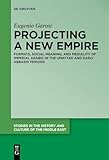Projecting a New Empire : Formats, Social Meaning, and Mediality of Imperial Arabic in the Umayyad and Early Abbasid Periods / Eugenio Garosi.
Material type: TextSeries: Studies in the History and Culture of the Middle East ; 42Publisher: Berlin ; Boston : De Gruyter, [2022]Copyright date: ©2022Description: 1 online resource (XXI, 443 p.)Content type:
TextSeries: Studies in the History and Culture of the Middle East ; 42Publisher: Berlin ; Boston : De Gruyter, [2022]Copyright date: ©2022Description: 1 online resource (XXI, 443 p.)Content type: - 9783110740721
- 9783110740974
- 9783110740820
- 492.709 23/eng/20220502
- PJ6075 .G37 2022
- online - DeGruyter
- Issued also in print.
| Item type | Current library | Call number | URL | Status | Notes | Barcode | |
|---|---|---|---|---|---|---|---|
 eBook
eBook
|
Biblioteca "Angelicum" Pont. Univ. S.Tommaso d'Aquino Nuvola online | online - DeGruyter (Browse shelf(Opens below)) | Online access | Not for loan (Accesso limitato) | Accesso per gli utenti autorizzati / Access for authorized users | (dgr)9783110740820 |
Browsing Biblioteca "Angelicum" Pont. Univ. S.Tommaso d'Aquino shelves, Shelving location: Nuvola online Close shelf browser (Hides shelf browser)

|

|

|

|

|

|

|
||
| online - DeGruyter Chemiephilosophie / | online - DeGruyter Reichweiten : Dynamiken und Grenzen kultureller Transferprozesse in Europa, 1400-1520. Grenzüberschreitung und Partikularisierung / | online - DeGruyter Literarische Aushandlungen von Liebe und Ökonomie / | online - DeGruyter Projecting a New Empire : Formats, Social Meaning, and Mediality of Imperial Arabic in the Umayyad and Early Abbasid Periods / | online - DeGruyter Ezekiel's Visionary Temple in Babylonian Context / | online - DeGruyter Pandemics Among Nations : U.S. Foreign Policy and the New Grand Chessboard / | online - DeGruyter Joshua and Judges in Yiddish Verse : Four Early Modern Epics. An Annotated Edition / |
Dissertation LMU München 2019.
Frontmatter -- Acknowledgements -- Contents -- List of Illustrations -- Note on Conventions -- Maps -- Introduction -- Becoming Empire -- Semantics of Empire -- Empires and Arab History -- Views on Early Islamic History -- A Review of the Documentary Evidence and Coping with its Limitations -- Previous Studies -- Approach and Methodology: Form over Substance -- The Definitional Trap: A Note on Terminology and Anachronism -- Timeframe -- Organization of this Study -- I Towards an Ecology of Documentary Arabic -- Introduction -- A Sudden Language: Pre-Islamic Arabic Writing and the Epigraphical Habit -- The Rise and Dissolution of “Imperial Arabic” (From Reichssprache to Lingua Franca) -- Concluding Remarks -- II Imperial Arabic: Between Text and Visual Text -- Introduction -- Images of the Word -- The Word and the Image: An Arab Late Antiquity -- From Image to Word -- The Eye of the Beholders -- Conclusion -- III Shaping Official Umayyad Arabic -- Introduction: Reichsarabisch or Early Islamic Official Arabic? -- If the Mountain Will Come: Arabic Letters -- If the Mountain Will Not Come: Official Inscriptions -- Umayyad Official Documentary Standard as Early Islamic Documentary Standard -- Conclusion -- IV A Culture of Ambivalence -- Negotiating “Arab Style” -- Shifting Boundaries between Scribal Cultures in the Umayyad Empire -- Parallel Scribal Traditions: Numismatics -- Parallel Scribal Traditions: Independent Arab-Style Scribal Practices -- Conclusion -- V An Empire of Words -- Regional Idiolects in the Use of Administrative Loanwords in Documentary Arabic -- The Loanwords in Imperial Arabic (640–800) -- Regional Diversity in the Use of Administrative Loanwords in Early Islamic Documentary Arabic -- Terminology and Regional Settings: The Role of Umayyad Syria and the Looming Shadow of Abbasid Iraq -- Conclusion -- Summary and Conclusions -- Appendices -- Appendix 1: Formal and Layout Structure of Early Islamic Arabic Official Letters -- Appendix 2: Formal and Layout Structure of Early Islamic Official Inscriptions -- Appendix 3: Comparative Table of Early Islamic Arab-style Letters -- Bibliography -- Indices -- General Index -- Index Locorum I: Papyri -- Index Locorum II: Inscriptions
restricted access online access with authorization star
http://purl.org/coar/access_right/c_16ec
Seventh and eighth-century papyri, inscriptions, and coins constitute the main evidence for the rise of Arabic as a hegemonic language emerging from the complex fabric of Graeco-Roman-Iranian Late Antiquity. This volume examines these sources in order to gauge the social ecology of Arabic writing within the broader late antique continuum. Starting from the functional interplay of Arabic with other languages in multilingual archives as well as the mediality of practices of public Arabic writing, the study correlates the rise of Arabic as an imperial language to social interactions: the negotiation between the Arab-Muslim imperial elite and non-Arabicized regional elites of the early Islamic empire. Using layout, formulae and technical terminology to trace common patterns and disruptions across sources from the Atlantic to Central Asia, the volume illuminates the distinctive formal varieties of official Umayyad and early Abbasid imperial documents compared to informal Arabic writings as well as to neighboring scribal traditions in other languages. The volume connects documentary practices to broader imperial policies, opening an unprecedented window into the strategies of governance that lay at the core of the early Islamic empire.
Issued also in print.
Mode of access: Internet via World Wide Web.
In English.
Description based on online resource; title from PDF title page (publisher's Web site, viewed 29. Mai 2023)


